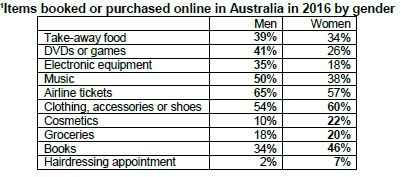
Despite spending more than women for the year, male spending dropped significantly from $6,500 to $3,600, while female spending was up from $2,400 to $3,100.
Sensis Commercial Director, Rob Tolliday, said: “The purchasing behaviours don’t follow gender stereotypes in all cases. The number of males buying groceries jumped this year, with very little now separating males and females. And one in ten men are now also buying cosmetics online, which is almost half the number of women.”
The study,by Sensis surveyed 1,000 Australian small and medium businesses and 800 Australian consumers about their online experiences and found that more than seven in 10 Australians (71 percent) made purchases online this year, up 10 percentage points from last year.
“While more Australian’s are making purchases online, they remain uneasy about using e-commerce. Hacking is by far the biggest concern, with 85 percent worrying about their private information being stolen or misused and the same number worrying about their credit card details,” said Mr Tolliday.
Streaming services are impacting on device ownership in the home, with penetration of digital TVs (down from 70 percent to 61 percent), pay TV (down from 31 percent to 27 percent) and 3D TV (down from 17 percent to 11 percent) all going backwards this year.
“Netflix and other streaming services are changing the way we consume entertainment in the home. They also appear to be making us fussier. Satisfaction with home internet speeds has declined, with one in four now grumpy about how long their content takes to load,” said Mr Tolliday.
Overseas purchases increased slightly, up from 21 percent to 23 percent, but local sales continue to dominate online. More than two thirds of Australian SMBs (67 percent) are primarily selling to businesses in their local city or town, while only two percent make most of their sales to overseas customers.
Of businesses with the internet 54 percent now sell online, with online sales growing from 32 percent to 43 percent of their total sales over the past four years.
“While sites such as Amazon offer consumers more choice, the falling Aussie dollar has seen overseas purchases remain steady, with less than a quarter of online purchases being made on overseas sites,” said Mr Tolliday.
“From a business perspective e-commerce is increasingly important as fewer shops have a physical store front and those that do have to battle with major overseas retailers who have landed in the key shopping strips.”

Not surprisingly, the survey found that people in regional areas are much less likely to have made online purchases. Less than one in five booked a restaurant online (18 percent regional vs 35 percent metro) and a similar amount booked a medical appointment via the web (20 percent regional vs 26 percent metro).
“While people in regional areas are less likely to make online purchases, when it comes to technology in the home, they are more likely to have a digital TV than their friends in the city, with ownership rates now at 65 percent,” said Mr Tolliday.
The full report, video, and infographics can be found at www.sensis.com.au/ebusinessreport.



















